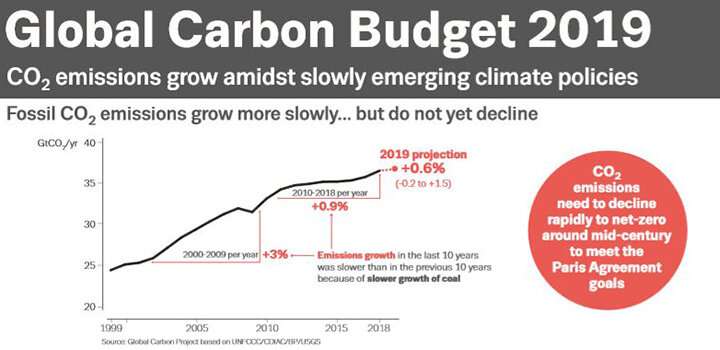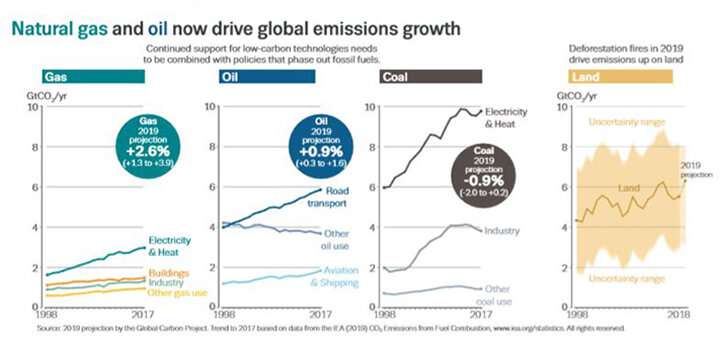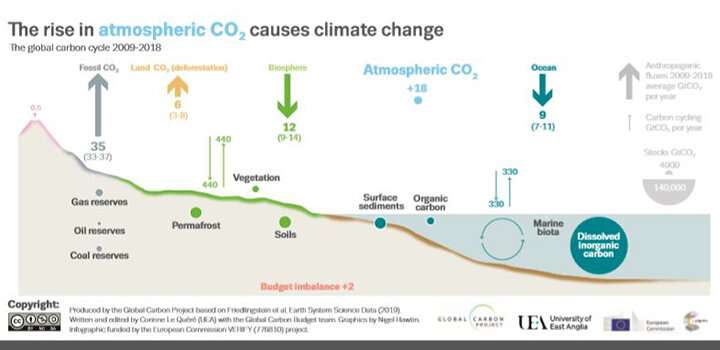Credit: University of East Anglia
Global carbon emissions are set to grow more slowly in 2019, with a decline in coal burning offset by strong growth in natural gas and oil use worldwide—according to researchers at the University of East Anglia (UEA), University of Exeter and the Global Carbon Project.
Emissions from burning fossil fuels are projected to grow by 0.6 percent (range: -0.2 to +1.5 percent) this year to reach almost 37 billion tonnes of carbon dioxide (CO2). This is down from 1.5 percent in 2017 and 2.1 percent in 2018.
This lower rate of growth is due to substantial declines in coal use in the EU and US, and slower growth in coal use in China and India compared to recent years. Weaker economic growth has also contributed to this trend.
Natural gas has seen the fastest fossil fuel emissions growth in 2019, with a projected increase of 2.6 percent (+1.3 to +3.9 percent). Oil used in transport is also driving emissions up, with a projected increase of 0.9 percent (+0.3 to +1.6 percent) this year, while emissions from coal burning are projected to decrease by 0.9 percent (-2.0 to +0.2 percent).Emissions this year are likely to be 4 percent higher than in 2015, the year of the UN Paris Agreement.
As international Governments gather at the UN Conference of the Parties (COP25) in Madrid this week, the team behind the annual update of the Global Carbon Project call for policies directed at phasing out the use of fossil fuels, in addition to more urgent and large-scale deployment of renewable energy and other low-carbon technologies.
Lead researcher Prof Pierre Friedlingstein, of the University of Exeter, said: "A failure to promptly tackle the driving factors behind continued emissions growth will limit the world's ability to shift to a pathway consistent with 1.5°C or well below 2°C of global warming, the aim of the Paris Climate Agreement.
"The science is clear, CO2 emissions need to decrease to net zero globally to stop further significant warming of the planet."
What else is happening?
The slower growth in 2019 is aligned with trends of the past decade. Global fossil CO2 emissions grew on average 0.9 percent a year since 2010, slower than the 3 percent a year of the 2000's.Preliminary estimates of emissions from fire deforestation and other land-use change for 2019 reached 6 billion tonnes of CO2 about 0.8 billion tonnes above 2018 levels. This increase stems partly from elevated fire activity in the Amazon, in line with data from the Brazilian Space Agency showing that deforestation in the Brazilian part of the Amazon has steadily increased since 2008, reaching its highest level in 2019. Fire activity was also unusually high in deforestation zones of Indonesia.
Credit: University of East Anglia
Total CO2 emissions from human activities—including combustion of fossil fuels and land use change—are set to reach 43.1 billion tonnes (39.9 to 46.2 GtCO2) in 2019.
Concentrations of CO2 in the atmosphere continue to grow and are projected to reach 410 parts per million averaged over the year. Atmospheric CO2 concentration in 2019 is 47 percent above pre-industrial levels.
Prof Corinne Le Quéré, Royal Society Research Professor at UEA's School of Environmental Sciences, contributed to this year's analysis. She said: "Current climate and energy policies are too weak to reverse trends in global emissions.
"Policies have been successful to varying degrees in deploying low-carbon technologies, such as solar, wind and electric vehicles. But these often add to existing demand for energy rather than displacing technologies that emit CO2 , particularly in countries where energy demand is growing. We need stronger policies that are targeted at phasing out the use of fossil fuels."
Globally, around 45 percent of fossil CO2 emissions come from the energy sector, mainly electricity and heat production. Industry, such as metal production, chemicals, and manufacturing, contribute 22 percent. Land transport together with national shipping and aviation are responsible for 20 percent, while international shipping and aviation add another 3.7 percent. The remaining 10 percent includes additional emissions from sectors such as buildings, agriculture, fishing, and the military.
Despite a projected decline in coal use in 2019 (-0.9 percent), coal is still the main source (about 40 percent) of fossil fuel CO2 emissions. The last decade (2009-2018) saw emissions from coal grow at 0.6 percent, with no significant growth since 2012.
Burning gas emits about 40 percent less CO2 than coal per unit energy, but it is not a low-carbon fuel. While CO2 emissions are likely to decline when gas displaces coal in electricity production,
Global Carbon Project researchers say it is only a short-term solution at best. AllCO2 emissions will need to decline rapidly towards zero.
Credit: University of East Anglia
How different countries compare
China's emissions continue to grow in 2019 and are projected to increase by 2.6 percent (+0.7 to +4.4 percent). The modest growth in coal use in China this year is due to low growth in electricity demand and no growth in coal-fired power generation, but pushed up somewhat by stronger growth in production of cement, steel and other energy-intensive products. China accounts for 50 percent of global coal use. A global peak in coal use is highly dependent on the future use of coal in China, which will depend on structural changes and energy and climate policy in China.
In the US emissions are projected to fall by 1.7 percent (-3.7 percent to +0.3 percent) in 2019, with a projected decrease of 10 percent in coal-based emissions. Coal is being displaced by gas, and to a lesser extent by solar and wind power. Electricity demand was also low in 2019. Oil use is projected to decline slightly in 2019, but is still likely to be over 1 percent higher than in 2017.
Growth in 2018 was high because of above normal home-heating requirements with cold winters. Natural gas use continues to grow strongly (+ 3.5 percent) due to low prices and its increased role in electricity generation.
EU28 emissions are projected to decline by 1.7 percent (-3.4 to +0.1 percent) in 2019, with a projected decrease of 10 percent in coal-based emissions, accelerating a trend of -5.1 percent per year since 2013. Electricity generation from coal has dropped by 22 percent through October compared with 2018, due to a sharp rise in the price of carbon in the EU Emissions Trading Scheme combined with additional policy factors. Consumption of both diesel and jet kerosene continue to increase, leading to a projected increase in emissions from oil products of 0.5 percent in 2019. Natural gas consumption continues to grow (+3 percent), although at a highly variable rate across EU member states.
Emissions in India are projected to rise by 1.8 percent (+0.7 to +3.7 percent) in 2019, considerably lower than in 2018. India's economy has slowed significantly through 2019, affecting consumption of coal and oil, and production of cement.
A strong monsoon also affected coal production and consumption, with heavy rainfall leading to both flooded coal mines and high hydropower generation.For the rest of the world, emissions are projected to rise by 0.5 percent (-0.8 to +1.8 percent) in 2019, based on projections of weaker economic growth of the International Monetary Fund (IMF).
In a separate analysis published earlier this year, members of the Global Carbon Budget team showed that the 18 countries that decarbonised the fastest in the past decade generally shared three characteristics:
- They had stable or declining energy use, from both energy efficiency and energy use;
- They deployed lots of renewable energy that replaced fossil energy;
- They had lots of climate and energy policies.
Data for the Global Carbon Budget 2019 is published today simultaneously in the journals Nature Climate Change, Earth System Science Data and Environmental Research Letters.
Journal information: Environmental Research Letters
Provided by University of East Anglia


























